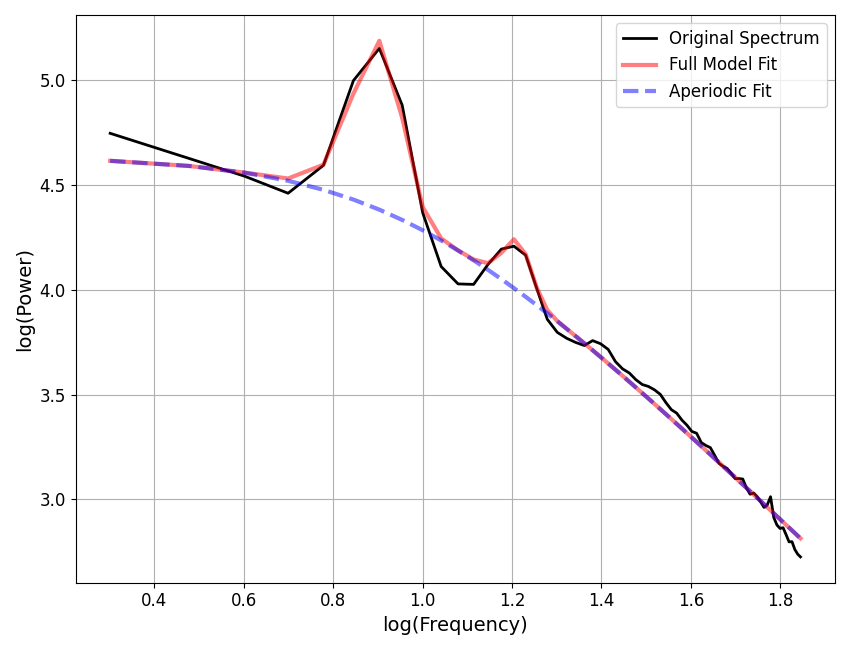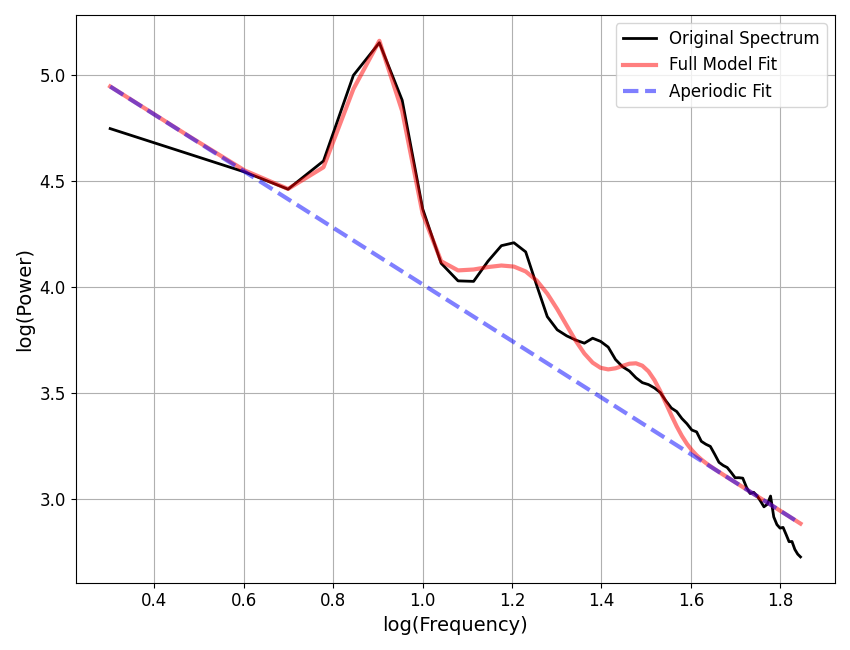Note
Go to the end to download the full example code.
05: Aperiodic Component Fitting¶
Choosing and using different modes for fitting the aperiodic component.
# Import the FOOOF object
from fooof import FOOOF
# Import a utility to download and load example data
from fooof.utils.download import load_fooof_data
Aperiodic Fitting Approaches¶
There are currently two approaches for fitting the aperiodic component:
Fitting with just an offset and a exponent, equivalent to a linear fit in log-log space
aperiodic_mode = ‘fixed’
Including a ‘knee’ parameter, reflecting a fit with a bend, in log-log space
aperiodic_mode = ‘knee’
Fitting in the ‘fixed’ mode assumes a single 1/f like characteristic to the aperiodic component, meaning it looks linear across all frequencies in log-log space.
Though this assumption is true across some frequency ranges in neural data, it generally does not hold up across broad frequency ranges. If fitting is done in the ‘fixed’ mode, but the assumption of a single 1/f is violated, then fitting will go wrong.
Broad frequency ranges (typically ranges greater than ~40 Hz range) typically do not have a single 1/f, as assumed by ‘fixed’ mode, as they typically exhibit a ‘bend’ in the aperiodic component. This indicates that there is not a single 1/f property across all frequencies, but rather a ‘bend’ in the aperiodic component. For these cases, fitting should be done using an extra parameter to capture this, using the ‘knee’ mode.
Fitting with an Aperiodic ‘Knee’¶
Let’s explore fitting power spectrum models across a broader frequency range, using some local field potential data.
# Load example data files needed for this example
freqs = load_fooof_data('freqs_lfp.npy', folder='data')
spectrum = load_fooof_data('spectrum_lfp.npy', folder='data')
# Fit a power spectrum model
# Note that this time we're specifying an optional parameter to plot in log-log
fm.report(freqs, spectrum, [2, 70], plt_log=True)

==================================================================================================
FOOOF - POWER SPECTRUM MODEL
The model was run on the frequency range 2 - 70 Hz
Frequency Resolution is 1.00 Hz
Aperiodic Parameters (offset, knee, exponent):
6.5759, 87.2235, 2.0354
2 peaks were found:
CF: 7.98, PW: 0.806, BW: 2.03
CF: 16.32, PW: 0.233, BW: 2.29
Goodness of fit metrics:
R^2 of model fit is 0.9925
Error of the fit is 0.0405
==================================================================================================
A note on interpreting the ‘knee’ parameter¶
The aperiodic fit has the form:
The knee parameter reported above corresponds to k in the equation.
This parameter is dependent on the frequency at which the aperiodic fit transitions from horizontal to negatively sloped.
To interpret this parameter as a frequency, take the \(\chi\)-th root of k, i.e.:
Interpreting the fit results when using knee fits is more complex, as the exponent result is no longer a simple measure of the aperiodic component as a whole, but instead reflects the aperiodic component past the ‘knee’ inflecting point. Because of this, when doing knee fits, knee & exponent values should be considered together.
Example: Aperiodic Fitting Gone Wrong¶
In the example above, we jumped directly to fitting with a knee.
Here we will explore what it looks like if we don’t use the appropriate mode for fitting the aperiodic component - fitting in ‘fixed’ mode when we should use ‘knee’

==================================================================================================
FOOOF - POWER SPECTRUM MODEL
The model was run on the frequency range 2 - 70 Hz
Frequency Resolution is 1.00 Hz
Aperiodic Parameters (offset, exponent):
5.3476, 1.3360
3 peaks were found:
CF: 8.01, PW: 1.020, BW: 2.41
CF: 17.02, PW: 0.369, BW: 8.00
CF: 31.05, PW: 0.273, BW: 8.00
Goodness of fit metrics:
R^2 of model fit is 0.9847
Error of the fit is 0.0607
==================================================================================================
In this case, we see that the ‘fixed’ aperiodic component (equivalent to a line in log-log space) is not able to capture the data, which has a curve.
To compensate, the model adds extra peaks, but these are also not a good characterization of the data.
In this example, the data, over this frequency range, needs to be fit in ‘knee’ mode to be able to appropriately characterize the data.
Choosing an Aperiodic Fitting Procedure¶
It is important to choose the appropriate aperiodic fitting approach for your data.
If there is a clear knee in the power spectrum, fitting in ‘fixed’ mode will not work well. However fitting with a knee may perform sub-optimally in ambiguous cases (where the data may or may not have a knee), or if no knee is present.
Given this, we recommend:
Check your data, across the frequency range of interest, for what the aperiodic component looks like.
If it looks roughly linear (in log-log space), fit without a knee.
This is likely across smaller frequency ranges, such as 3-30.
Do not perform no-knee fits across a range in which this does not hold.
If there is a clear knee, then use knee fits.
This is likely across larger fitting ranges such as 1-150 Hz.
Be wary of ambiguous ranges, where there may or may not be a knee.
Trying to fit without a knee, when there is not a single consistent aperiodic component, can lead to very bad fits. However, trying to fit with a knee may lead to suboptimal fits when no knee is present, and makes interpreting the exponent more difficult.
We therefore currently recommend picking frequency ranges in which the expected aperiodic component process is relatively clear.
Conclusion¶
We have now explored the FOOOF object, and different fitting
approaches for the aperiodic component. Next up, we will be introducing how
to scale the fitting to apply across multiple power spectra.
Total running time of the script: (0 minutes 0.450 seconds)